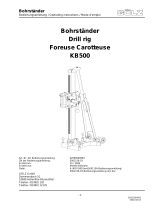
away from moving parts. Loose clothes, jewellery
or long hair can be caught in moving parts.
g) If devices are provided for the connection of dust
extraction and collection facilities, ensure these
are connected and properly used. Use of dust
collection can reduce dust-related hazards.
4.1.4 Power tool use and care
a) Do not force the power tool. Use the correct
power tool for your application. The correct power
tool will do the job better and safer at the rate for
which it was designed.
b) Do not use the power tool if the switch does not
turn it on and off. Any power tool that cannot be
controlled with the switch is dangerous and must be
repaired.
c) Disconnect the plug from the power source
and/or the battery pack from the power tool
before making any adjustments, changing
accessories, or storing power tools. Such
preventive safety measures reduce the risk of
starting the power tool accidentally.
d) Store idle power tools out of the reach of chil-
dren and do not allow persons unfamiliar with the
power tool or these instructions to operate the
power tool. Power tools are dangerous in the hands
of untrained users.
e) Maintain power tools. Check for misalignment or
binding of moving parts, breakage of parts and
any other condition that may affect the power
tool’s operation. If damaged, have the power tool
repaired before use. Many accidents are caused by
poorly maintained power tools.
f) Keep cutting tools sharp and clean. Properly main-
tained cutting tools with sharp cutting edges are less
likely to bind and are easier to control.
g) Use the power tool, accessories and tool bits etc.
in accordance with these instructions, taking into
account the working conditions and the work to
be performed. Use of the power tool for opera-
tions different from those intended could result in a
hazardous situation.
4.1.5 Service
a) Haveyour power tool servicedby a qualifiedrepair
person using only identical replacement parts.
This will ensure that the safety of the power tool is
maintained.
4.2 Proper organization of the work area
a) The machine may be operated only with a func-
tional ground fault circuit interrupter (RCD resid-
ual current device). Check each time before use
that your electric supply is equipped with a ground
fault circuit interrupter. Make sure that the ground
fault circuit interrupter is functioning.
b) Approval must be obtained from the site engineer
or architectprior to beginning drillingwork. Drilling
work on buildings and other structures may influence
the statics of the structure, especially when steel
reinforcing bars or load-bearing components are cut
through.
c) When drilling through walls, secure (cordon off)
the area behind the wall, as material or the core
may fall out on the other side of the wall. When
drilling through ceilings, secure (cordon off) the
area below as drilled material or the core may
drop out and fall down.
d) In order to avoid accidents in which persons fall
and injure themselves, the opening that is created
must be securely and visibly cordoned off.
e) Place the mounting device on a solid, flat and level
surface. If the mounting device can slip or wobble,
the machine cannot be guided smoothly and safely.
f) Check the nature of the surface.
Rough surfaces
may reduce the holding power of the drill stand.
Coatings or composite materials may pull away from
the surface while you are working, so that the drill
stand with the core drilling machine are no longer
held securely.
g) Do not overload the mounting device and do not
use it as a substitute for a ladder or platform.
Overloading the mounting device or standing on it
may shift its center of gravity to a higher position,
causingittotipover.
h) Wear respiratory protection if the work causes
dust.
i) Ensure that the workplace is well ventilated.
j) It is recommended that rubber gloves and non-
skid shoes are worn when working outdoors.
k) Keep the supply cord, extension cord, suction
hose and vacuum hose away from rotating parts.
l) Don’t work from a ladder.
m) Keep the workplace tidy. Objects which could
cause injury should be removed from the work-
ing area. Untidiness at the workplace can lead to
accidents.
n) Secure the workpiece. Use clamps or a vice to
secure the workpiece. The workpiece is thus held
more securely than by hand and both hands remain
free to operate the machine.
o) Always lead the supply cord and extension cord
away from the power tool to the rear while work-
ing. This helps to avoid tripping over the cord while
working.
4.2.1 General safety rules
a) Fit the protective cover cap only when the drilling
feed unit is unplugged. Operate the core drilling
machine only when the connecting socket is
covered, i.e.when the protective cover cap is fit-
ted. If the protective cover cap is missing, contact
Hilti Service and obtain a replacement. Unplug the
core drilling machine from the electric supply im-
mediately if water enters the connecting socket.
Check to ensure that the connecting socket is
dry before making further use of the core drilling
machine. The connecting socket may fill with water
if it is not covered by the protective cap or if the
en
25
Printed: 31.03.2017 | Doc-Nr: PUB / 5209077 / 000 / 02Printed: 29.05.2017 | Doc-Nr: PUB / 5209077 / 000 / 03




















